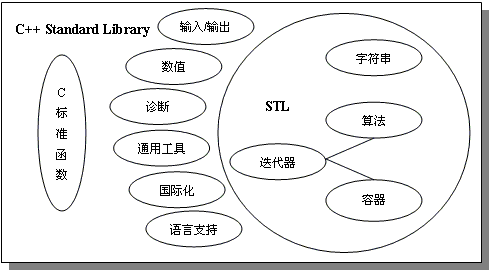第一个C++ STL程序代码:
#include <stdio.h>
int main()
{
printf("hello world!");
return 0;
}
STL(Standard Template Library),即标准模板库,是一个具有工业强度的,高效的C++程序库。它被容纳于C++标准程序库(C++ Standard Library)中,是ANSI/ISO C++标准中最新的也是极具革命性的一部分。该库包含了诸多在计算机科学领域里所常用的基本数据结构和基本算法。为广大C++程序员们提供了一个可扩展的应用框架,高度体现了软件的可复用性。这种现象有些类似于Microsoft Visual C++中的MFC(Microsoft Foundation Class Library),或者是Borland C++ Builder中的VCL(Visual Component Library),对于此二者,大家一定不会陌生吧。
从逻辑层次来看,在STL中体现了泛型化程序设计的思想(generic programming),引入了诸多新的名词,比如像需求(requirements),概念(concept),模型(model),容器(container),算法(algorithmn),迭代子(iterator)等。与OOP(object-oriented programming)中的多态(polymorphism)一样,泛型也是一种软件的复用技术。
从实现层次看,整个STL是以一种类型参数化(type parameterized)的方式实现的,这种方式基于一个在早先C++标准中没有出现的语言特性–模板(template)。如果查阅任何一个版本的STL源代码,你就会发现,模板作为构成整个STL的基石是一件千真万确的事情。除此之外,还有许多C++的新特性为STL的实现提供了方便。
C++ STL快速入门
在数月之前的机试中第一次体验到STL的威力,因为自己本来一直在用C语言做开发,很多数据结构都是自己造的,比如链表、队列等,第一次接触C++ STL后发现这些数据结构都已经给我提供好了,我直接拿去调用就好了,真是超级方便。最近的项目中也遇到了STL一些容器,所以现在自己好好总结一下STL中一些最常用的容器的使用方法,方便自己日后查阅。
C++ STL中最基本以及最常用的类或容器无非就是以下几个:
- string
- vector
- set
- list
- map
下面就依次介绍它们,并给出一些最常见的最实用的使用方法,做到快速入门。
string
首先看看我们C语言一般怎么使用字符串的
char* s1 = "Hello SYSU!"; //创建指针指向字符串常量,这段字符串我们是不能修改的 //想要创建 可以修改的字符串,我们可以使用数组分配空间 char s2[20] = "Hello SYSU!"; //或者这样 char s3[] = "Hello SYSU!"; //当然我们也可以动态分配内存 char* s4 = (char*)malloc(20); gets(s4);
C++ 标准库中的string表示可变长的字符串,它在头文件string里面。
#include <string>
用string初始化字符串分两类:用“=”号就是拷贝初始化,否则就是直接初始化。

string s1;//初始化字符串,空字符串
string s2 = s1; //拷贝初始化,深拷贝字符串
string s3 = "I am Yasuo"; //直接初始化,s3存了字符串
string s4(10, 'a'); //s4存的字符串是aaaaaaaaaa
string s5(s4); //拷贝初始化,深拷贝字符串
string s6("I am Ali"); //直接初始化
string s7 = string(6, 'c'); //拷贝初始化,cccccc
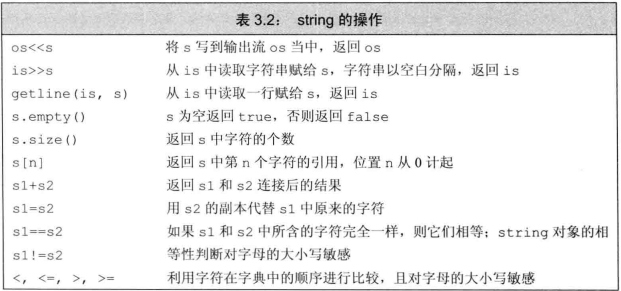
#include <iostream>
#include <string>
using namespace std;
int main()
{
string s1;//初始化字符串,空字符串
string s2 = s1; //拷贝初始化,深拷贝字符串
string s3 = "I am Yasuo"; //直接初始化,s3存了字符串
string s4(10, 'a'); //s4存的字符串是aaaaaaaaaa
string s5(s4); //拷贝初始化,深拷贝字符串
string s6("I am Ali"); //直接初始化
string s7 = string(6, 'c'); //拷贝初始化,cccccc
//string的各种操作
string s8 = s3 + s6;//将两个字符串合并成一个
s3 = s6;//用一个字符串来替代另一个字符串的对用元素
cin >> s1;
cout << s1 << endl;
cout << s2 << endl;
cout << s3 << endl;
cout << s4 << endl;
cout << s5 << endl;
cout << s6 << endl;
cout << s7 << endl;
cout << s8 << endl;
cout << "s7 size = " << s7.size() << endl; //字符串长度,不包括结束符
cout << (s2.empty() ? "This string is empty" : "This string is not empty") << endl;;
system("pause");
return 0;
}
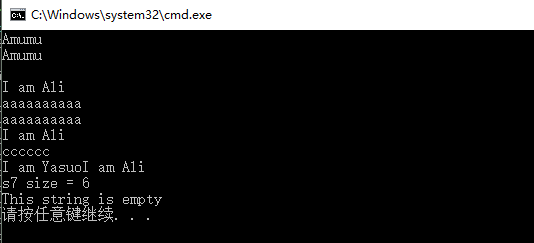
string的IO操作
使用cin读入字符串时,遇到空白就停止读取。比如程序输入的是
" Hello World"
那么我们得到的字符串将是”Hello”,前面的空白没了,后面的world也读不出来。
如果我们想把整个hello world读进来怎么办?那就这样做
cin>>s1>>s2;
hello存在s1里,world存在s2里了。
有时我们想把一个句子存下来,又不想像上面那样创建多个string来存储单词,怎么办?
那就是用getline来获取一整行内容。
string str; getline(cin, str); cout << str << endl;
当把string对象和字符面值及字符串面值混在一条语句中使用时,必须确保+的两侧的运算对象至少有一个是string
string s1 = s2 + ", "; //正确 string s3 = "s " + ", "; //错误 string s4 = "hello" + ", " + s1; //错误 string s5 = s1 + "hello " + ", "; //改一下顺序,s1放前头,正确了,注意理解=号右边的运算顺序
处理string中的字符
访问字符串的每个字符
for (int i = 0; i < s3.size(); i++)
{
cout << s3[i] << endl;
s3[i] = 's';
}
在C语言中我都是用下标或者指针来访问数组元素,而在C++里,有个新奇的东西叫做迭代器iterator,我们可以使用它来访问容器元素。

string str("hi sysu");
for (string::iterator it = str.begin(); it != str.end(); it++)
{
cout << *it << endl;
}
我们也可以是使用const_iterator使得访问元素时是能读不能写,这跟常量指针意思差不多。
string str2("hi sysu");
for (string::const_iterator it = str2.begin(); it != str2.end(); it++)
{
cout << *it << endl;
*it = 'l'; //这是错误的,不能写
}
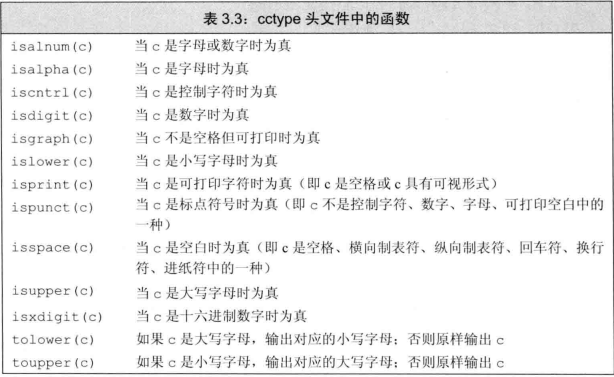
string还有一些很好用的函数,比如找子串
string sq("heoolo sdaa ss");
cout << s.find("aa", 0) << endl; //返回的是子串位置。第二个参数是查找的起始位置,如果找不到,就返回string::npos
if (s.find("aa1", 0) == string::npos)
{
cout << "找不到该子串!" << endl;
}
vector
C++ STL中的verctor好比是C语言中的数组,但是vector又具有数组没有的一些高级功能。与数组相比,vector就是一个可以不用再初始化就必须制定大小的边长数组,当然了,它还有许多高级功能。
要想用vector首先得包含头文件vector。
#include <vector>
怎么初始化?

如果vector的元素类型是int,默认初始化为0;如果vector元素类型为string,则默认初始化为空字符串。
vector<int> v1;
vector<father> v2;
vector<string> v3;
vector<vector<int> >; //注意空格。这里相当于二维数组int a[n][n];
vector<int> v5 = { 1,2,3,4,5 }; //列表初始化,注意使用的是花括号
vector<string> v6 = { "hi","my","name","is","lee" };
vector<int> v7(5, -1); //初始化为-1,-1,-1,-1,-1。第一个参数是数目,第二个参数是要初始化的值
vector<string> v8(3, "hi");
vector<int> v9(10); //默认初始化为0
vector<int> v10(4); //默认初始化为空字符串
如何向vector添加元素?
请使用push_back加入元素,并且这个元素是被加在数组尾部的。
for (int i = 0; i < 20; i++)
{
v1.push_back(i);
}
vector其他的操作
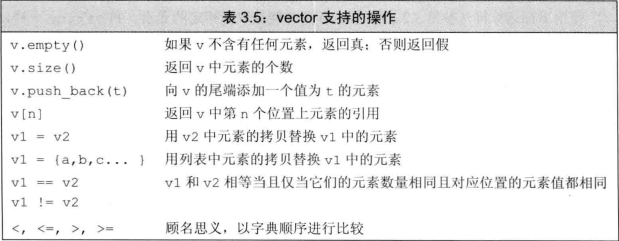
访问和操作vector中的每个元素
for (int i = 0; i < v1.size(); i++)
{
cout << v1[i] << endl;
v1[i] = 100;
cout << v1[i] << endl;
}
注意:只能对已存在的元素进行赋值或者修改操作,如果是要加入新元素,务必使用push_back。push_back的作用有两个:告诉编译器为新元素开辟空间、将新元素存入新空间里。
比如下面的代码是错误的,但是编译器不会报错,就像是数组越界。
vector<int> vec; vec[0] = 1; //错误!
当然我们也可以选择使用迭代器来访问元素
vector<string> v6 = { "hi","my","name","is","lee" };
for (vector<string>::iterator iter = v6.begin(); iter != v6.end(); iter++)
{
cout << *iter << endl;
//下面两种方法都行
cout << (*iter).empty() << endl;
cout << iter->empty() << endl;
}
上面是正向迭代,如果我们想从后往前迭代该如何操作?
使用反向迭代器
for (vector<string>::reverse_iterator iter = v6.rbegin(); iter != v6.rend(); iter++)
{
cout << *iter << endl;
}
vector最常用的增删操作
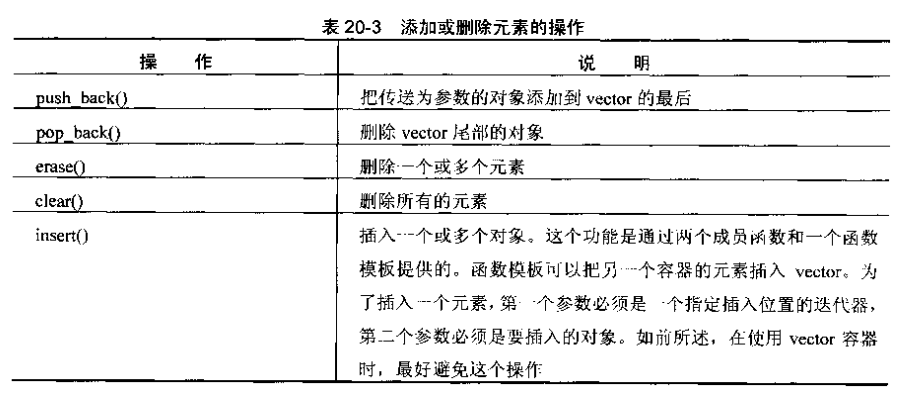
#include <iostream>
#include <vector>
#include <string>
using namespace std;
template <typename T>
void showvector(vector<T> v)
{
for (vector<T>::iterator it = v.begin(); it != v.end(); it++)
{
cout << *it;
}
cout << endl;
}
int main()
{
vector<string> v6 = { "hi","my","name","is","lee" };
v6.resize(3); //重新调整vector容量大小
showvector(v6);
vector<int> v5 = { 1,2,3,4,5 }; //列表初始化,注意使用的是花括号
cout << v5.front() << endl; //访问第一个元素
cout << v5.back() << endl; //访问最后一个元素
showvector(v5);
v5.pop_back(); //删除最后一个元素
showvector(v5);
v5.push_back(6); //加入一个元素并把它放在最后
showvector(v5);
v5.insert(v5.begin()+1,9); //在第二个位置插入新元素
showvector(v5);
v5.erase(v5.begin() + 3); //删除第四个元素
showvector(v5);
v5.insert(v5.begin() + 1, 7,8); //连续插入7个8
showvector(v5);
v5.clear(); //清除所有内容
showvector(v5);
system("pause");
return 0;
}
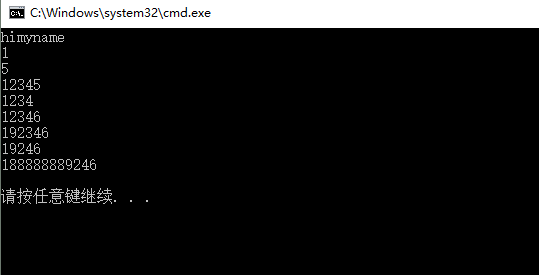
注意:虽然vertor对象可以动态增长,但是也或有一点副作用:已知的一个限制就是不能再范围for循环中向vector对象添加元素。另外一个限制就是任何一种可能改变vector对象容量的操作,不如push_back,都会使该迭代器失效。
总而言之就是:但凡使用了迭代器的循环体,都不要向迭代器所属的容器添加元素!
C++中push_back和insert两个有什么区别?
顾名思义push_back把元素插入容器末尾,insert把元素插入任何你指定的位置。
不过push_back速度一般比insert快。如果能用push_back尽量先用push_back。
set
set跟vector差不多,它跟vector的唯一区别就是,set里面的元素是有序的且唯一的,只要你往set里添加元素,它就会自动排序,而且,如果你添加的元素set里面本来就存在,那么这次添加操作就不执行。要想用set先加个头文件set。
#include <set>
#include <iostream>
#include <set>
#include <string>
using namespace std;
template <typename T>
void showset(set<T> v)
{
for (set<T>::iterator it = v.begin(); it != v.end(); it++)
{
cout << *it;
}
cout << endl;
}
int main()
{
set<int> s1{9,8,1,2,3,4,5,5,5,6,7,7 }; //自动排序,从小到大,剔除相同项
showset(s1);
set<string> s2{ "hello","sysy","school","hello" }; //字典序排序
showset(s2);
s1.insert(9); //有这个值了,do nothing
showset(s1);
s2.insert("aaa"); //没有这个字符串,添加并且排序
showset(s2);
system("pause");
return 0;
}
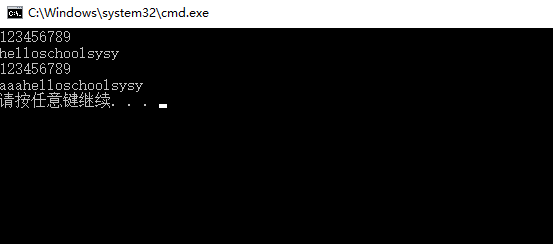
list
list就是链表,在C语言中我们想使用链表都是自己去实现的,实现起来倒不难,但是如果有现成的高效的链表可以使用的话,我们就不需要重复造轮子了。STL就提供了list容器给我们。
list是一个双向链表,而单链表对应的容器则是foward_list。
list即双向链表的优点是插入和删除元素都比较快捷,缺点是不能随机访问元素。
初始化方式就大同小异了,跟vector基本一样。要想用list先加个头文件list。
#include <list>
#include <iostream>
#include <list>
#include <string>
using namespace std;
template <typename T>
void showlist(list<T> v)
{
for (list<T>::iterator it = v.begin(); it != v.end(); it++)
{
cout << *it;
}
cout << endl;
}
int main()
{
list<int> l1{ 1,2,3,4,5,5,6,7,7 };
showlist(l1);
list<double> l2;
list<char> l3(10);
list<int> l4(5, 10); //将元素都初始化为10
showlist(l4);
system("pause");
return 0;
}
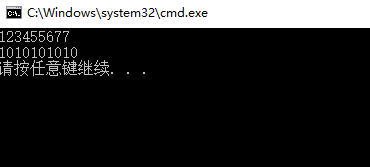
值得注意的是,list容器不能调用algorithm下的sort函数进行排序,因为sort函数要求容器必须可以随机存储,而list做不到。所以,list自己做了一个自己用的排序函数,用法如下:
list<int> l1{ 8,5,7,6,1,2,3,4,5,5,6,7,7 };
l1.sort();
map
map运用了哈希表地址映射的思想,也就是key-value的思想,来实现的。
首先给出map最好用也最最常用的用法例子,就是用字符串作为key去查询操作对应的value。
要使用map得先加个头文件map。
#include <map>
#include <iostream>
#include <map>
#include <string>
using namespace std;
void showmap(map<string, int> v)
{
for (map<string, int>::iterator it = v.begin(); it != v.end(); it++)
{
cout << it->first << " " << it->second << endl; //注意用法,不是用*it来访问了。first表示的是key,second存的是value
}
cout << endl;
}
int main()
{
map<string, int> m1; //<>里的第一个参数表示key的类型,第二个参数表示value的类型
m1["Kobe"] = 100;
m1["James"] = 99;
m1["Curry"] = 98;
string s("Jordan");
m1[s] = 90;
cout << m1["Kobe"] << endl;
cout << m1["Jordan"] << endl;
cout << m1["Durant"] << endl; //不存在这个key,就显示0
m1.erase("Curry");//通过关键字来删除
showmap(m1);
m1.insert(pair<string, int>("Harris", 89)); //也可以通过insert函数来实现增加元素
showmap(m1);
m1.clear(); //清空全部
system("pause");
return 0;
}
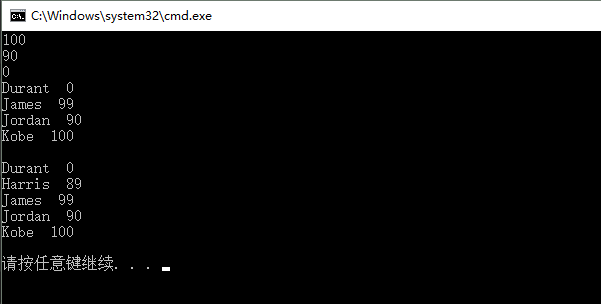
如果想看看某个存不存在某个key,可以用count来判断
if (m1.count("Lee"))
{
cout << "Lee is in m1!" << endl;
}
else
{
cout << "Lee do not exist!" << endl;
}
用迭代器来访问元素
for (map<string, int>::iterator it = m1.begin(); it != m1.end(); it++)
{
cout << it->first<<" "<<it->second << endl; //注意用法,不是用*it来访问了。first表示的是key,second存的是value
}

